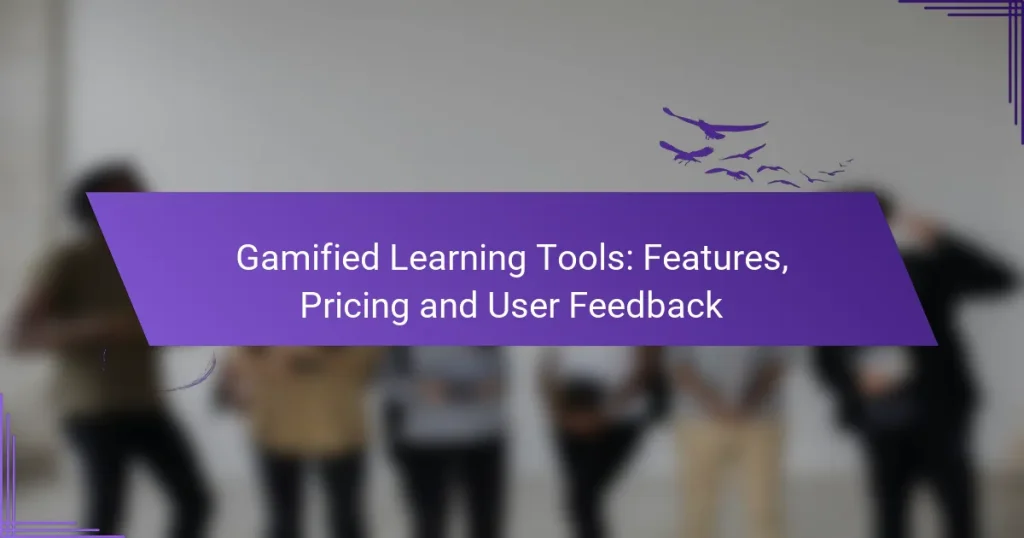Gamified learning tools are designed to boost engagement and retention in online courses by integrating interactive elements and game mechanics such as points, badges, and leaderboards. When choosing the right tool, it’s essential to consider features that enhance user interaction, track progress, and allow for customization and collaboration. Pricing for these tools varies widely, from free basic versions to premium subscriptions that can cost several hundred dollars annually, depending on the features and user capacity required.

What are the best gamified learning tools for online courses?
The best gamified learning tools for online courses enhance engagement and retention through interactive elements. These tools often incorporate game mechanics like points, badges, and leaderboards to motivate learners and make the educational experience more enjoyable.
Kahoot!
Kahoot! is a popular platform that allows educators to create interactive quizzes and games. Users can participate in real-time using their devices, which fosters a competitive yet fun atmosphere. The platform is particularly effective for formative assessments and can be used in various educational settings.
To maximize its effectiveness, consider creating visually appealing quizzes with a mix of question types. Avoid overly complex questions that may confuse participants and keep the game duration manageable, ideally under 30 minutes.
Quizizz
Quizizz offers a flexible approach to gamified learning, allowing students to complete quizzes at their own pace. This asynchronous format is beneficial for diverse learning environments, enabling learners to engage without the pressure of real-time competition.
Incorporate multimedia elements like images and videos to enhance quiz engagement. Be mindful of the length of quizzes; aim for around 10-15 questions to maintain student interest and focus.
Classcraft
Classcraft transforms the classroom experience into a role-playing game where students can earn points and rewards for positive behavior and academic achievements. This tool emphasizes collaboration and teamwork, making it ideal for group projects and classroom management.
To effectively implement Classcraft, set clear expectations and rules for behavior and participation. Regularly update challenges and quests to keep the content fresh and engaging for students.
Edmodo
Edmodo serves as a social learning platform that integrates gamification elements to enhance student engagement. It allows teachers to create assignments, quizzes, and polls while facilitating communication among students and educators.
Utilize Edmodo’s analytics features to track student progress and engagement levels. Encourage students to participate in discussions and provide feedback on assignments to foster a collaborative learning environment.
Nearpod
Nearpod combines interactive presentations with gamified elements, allowing educators to create engaging lessons that include quizzes, polls, and virtual reality experiences. This tool is particularly effective for visual and interactive learners.
When using Nearpod, ensure that lessons are well-structured and interactive. Limit the number of interactive elements per session to avoid overwhelming students, aiming for a balanced mix of content delivery and engagement activities.

What features should I look for in gamified learning tools?
When selecting gamified learning tools, focus on features that enhance user engagement, track progress effectively, offer customization options, and facilitate collaboration. These elements are crucial for creating an interactive and effective learning environment.
Engagement mechanics
Engagement mechanics are the core elements that keep learners motivated and involved. Look for features like points, badges, leaderboards, and challenges that encourage participation. Tools that incorporate storytelling or game-like scenarios can significantly enhance the learning experience.
Consider how these mechanics align with your learning objectives. For instance, if the goal is to foster competition, leaderboards may be beneficial, while badges can motivate learners to complete specific tasks. Ensure that the mechanics are not overwhelming but rather enhance the learning journey.
Progress tracking
Effective progress tracking allows learners to see their advancement and areas needing improvement. Look for tools that provide visual dashboards, completion rates, and feedback on performance. This transparency can motivate learners to engage more deeply with the material.
Consider tools that offer both individual and group progress tracking. Individual tracking helps learners understand their personal growth, while group tracking can foster a sense of community and accountability. Aim for tools that update progress in real-time to keep learners informed.
Customizability
Customizability is essential for tailoring the learning experience to meet specific needs. Choose tools that allow you to modify content, adjust difficulty levels, and personalize learning paths. This flexibility can enhance learner satisfaction and effectiveness.
Evaluate how easily you can adapt the tool to fit your audience. For example, if you’re targeting younger learners, you might want more colorful graphics and simpler language. Ensure that the customization options are user-friendly and do not require extensive technical knowledge.
Collaboration options
Collaboration options enable learners to work together, share insights, and support each other. Look for tools that include features like discussion forums, group challenges, or peer reviews. These elements can enhance the learning experience by fostering teamwork and communication skills.
Consider how collaboration can be integrated into the learning process. For instance, tools that allow for real-time collaboration on projects can enhance engagement and learning outcomes. Ensure that the collaboration features are intuitive and encourage participation from all learners.

How much do gamified learning tools cost?
Gamified learning tools typically range from free basic versions to premium subscriptions costing several hundred dollars annually. Pricing often depends on features, user capacity, and educational institutions’ needs.
Kahoot! pricing tiers
Kahoot! offers a free version with limited features, suitable for casual users and small groups. Their premium plans start around $3 to $6 per user per month, providing advanced features like detailed reports and increased participant limits.
For larger organizations, Kahoot! offers a Pro plan that can cost up to $20 per user per month, which includes additional functionalities such as branding options and enhanced game customization.
Quizizz subscription plans
Quizizz has a free tier that allows users to create quizzes and access a library of public quizzes. Their paid plans start at approximately $10 per month for individual teachers, offering features like advanced reporting and the ability to assign homework.
For schools and districts, Quizizz offers a plan that can range from $200 to $1,000 annually, depending on the number of users and specific features required.
Classcraft pricing model
Classcraft provides a free basic version for teachers, which includes limited features for classroom management and gamification. Their premium plans start at around $10 per month for individual teachers, unlocking advanced tools and customization options.
For schools, Classcraft offers a school-wide license that can range from $1,500 to $5,000 per year, depending on the number of students and additional support services included.
Edmodo pricing options
Edmodo is primarily free for teachers and students, offering essential features for classroom collaboration and communication. However, they also provide premium features through Edmodo Enterprise, which can cost schools between $2,000 and $10,000 annually, based on the number of users and specific needs.
Schools considering Edmodo should evaluate their requirements, as the premium features include enhanced analytics and support, which may justify the investment for larger educational institutions.

What do users say about gamified learning tools?
Users generally appreciate gamified learning tools for their engaging and interactive nature, which enhances motivation and retention. Feedback often highlights the effectiveness of these tools in making learning fun, though some users note challenges with accessibility and technical issues.
User reviews of Kahoot!
Kahoot! is widely praised for its user-friendly interface and vibrant game mechanics that encourage participation. Many educators report that it effectively boosts student engagement during lessons, making it a popular choice in classrooms.
However, some users mention limitations such as the need for reliable internet access and potential distractions from the competitive nature of the games. Teachers often recommend balancing Kahoot! with other instructional methods to cater to diverse learning styles.
User feedback on Quizizz
Quizizz receives positive feedback for its flexibility, allowing users to create quizzes that can be played live or assigned for homework. Users appreciate the immediate feedback provided to students, which helps reinforce learning.
On the downside, some educators find the platform’s reporting features less comprehensive compared to competitors. It’s advisable to explore these analytics to ensure they meet your assessment needs before fully committing.
Classcraft user experiences
Classcraft is noted for its unique approach, combining role-playing game elements with educational content. Users enjoy how it fosters collaboration and teamwork among students, making lessons more immersive.
Nevertheless, some feedback points to a steep learning curve for both teachers and students. To maximize its benefits, educators should invest time in training and familiarize themselves with the platform’s features to effectively integrate it into their teaching strategies.

What criteria should I use to select a gamified learning tool?
When selecting a gamified learning tool, consider factors such as user engagement, educational effectiveness, and pricing. Look for features that enhance learning experiences while fitting within your budget.
Features to look for
Key features of effective gamified learning tools include interactive elements, progress tracking, and rewards systems. Interactive elements keep learners engaged, while progress tracking allows both users and educators to monitor advancement. A rewards system, such as badges or points, can motivate users to continue learning.
Additionally, consider tools that offer customization options to tailor the learning experience to specific needs. Features like adaptive learning paths can enhance user engagement by providing personalized challenges.
Pricing models
Gamified learning tools typically offer various pricing models, including subscription-based, one-time purchase, or freemium options. Subscription models often range from $10 to $50 per month, depending on the features included. One-time purchases may vary widely, from $100 to several hundred dollars.
Freemium options allow users to access basic features for free while charging for advanced functionalities. Evaluate your budget and the potential return on investment when choosing a pricing model.
User feedback and reviews
User feedback is crucial when selecting a gamified learning tool. Look for reviews on platforms like G2 or Capterra to gauge user satisfaction and identify common issues. Pay attention to comments regarding usability, engagement levels, and educational outcomes.
Consider reaching out to current users or educators who have implemented the tool to gain insights into their experiences. This can provide a clearer picture of how the tool performs in real-world scenarios.


